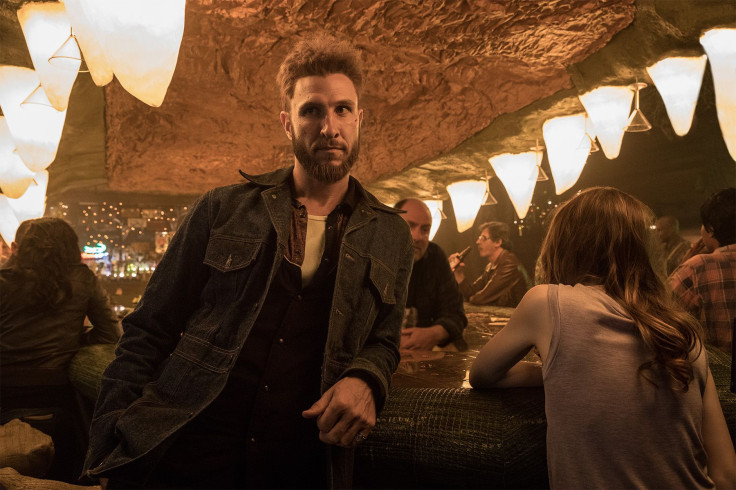American Gods ’ Mad Sweeney, played by Pablo Schreiber, is a man of contradictions: an outsized leprechaun who’d rather brawl than follow any kind of rainbow, a creature of good fortune who’s lost his luck, an indigent rich man, a sharp-tongued brawler instead of a beaming trickster. Episode 107 of American Gods, “Prayer for Mad Sweeney,” gives us loads of delicious backstory on how Sweeney came to America as well as a window into the life of one particular person who believed in “the little people” and “the fair folk.” We spoke with Schreiber to discuss Mad Sweeney: the man, the myth and the legend.
Schreiber’s favorite parts of Mad Sweeney are all those contradictions. “The initial setup obviously of the leprechaun who's lost his luck is really just a fun little place to play around in, and that's where we meet him, that's what the setup of the character involves: establishing the leprechaun who's lost his luck,” said Schreiber.
“And then the next step in the dynamic is throwing him into contact with somebody who's half his size, who he expects to be able to physically dominate and all of a sudden he realizes that it's not going to be as easy as he thought… So watching a guy who's used to getting his way and used to having all the good fortune in the world realize that his mojo's gone and then putting him in contact with somebody who's hafl his size and beats him up – basically watching him get beat up in every way possible is just a very, very fun dynamic,” said Schreiber.

But the next step in revealing Mad Sweeney’s hidden depths comes in episode 7. “You may or may not have noticed that a lot of the interactions that Sweeney has had with Laura throughout the season and even his initial interaction with Shadow in the Crocodile Bar are sort of emotionally weighted in a strange way, and you don't quite know why this guy is so heavily invested in some of these situations. And now, we get to peel the curtain back and we get to find out why, and we realize that he's been carrying around a huge amount of guilt for something that he did. And he wants to right that wrong,” said Schreiber.
Sweeney is haunted by ghosts from the very distant past, too. Emily Browning pulls double-duty in “Prayer for Mad Sweeney,” playing not only Laura, but also Essie McGowan, the Irish woman whose faith in the fair folk brought Sweeney over to America. “The fact that he was brought to this country by somebody who is very close in physical resemblance to Laura deepens their connection immensely,” said Schreiber.
But Essie was a long time ago. In American Gods, we see that America has been inhospitable to the old gods for almost as long as Sweeney has been there. As a leprechaun, Mad Sweeney may not be a capital-G god, but he’s still a part of the ineffable and divine. That makes the indignity of his characterization as a bumbling, friendly, harmless little mascot wear on him all the more. “It really comes off as a kind of insecurity,” said Schreiber. “A Napoleon complex... Tired of being reduced to a cartoon on a cereal box, and all he wants really desperately is for a seat at the table with the rest of the gods.”
While Mad Sweeney is a three-dimensional, complicated character on Starz’s American Gods , he only makes two appearances in the novel. Schreiber is pleased with the juicy role he plays and points to Sweeney’s scarcity in the novel as the very thing that gives the TV adaptation so much room to play with.
“The fact that you get to link him up with Laura and create a parallel road trip to the one that Wednesday and Shadow are on automatically opens the story up into a much bigger canvas than it was in the novel. It's one of the really effective things about the television adaptation,” said Schreiber. “The world instantly grows and rather than two protagonists, you have four that the audience can get behind and follow and start to put their allegiances with.”
The American Gods TV show fleshes the world out far past the novel’s scope, throwing together characters who may never have exchanged words in the original book. Sweeney and Laura’s banter is sharp and delightful; throw in Salim’s wide-eyed bafflement at their behavior and hilarity ensues. But Schreiber lays all the credit for that chemistry at the writers’ feet.
“The writing and set up is so rich,” said Schreiber. “Emily, Omid and I had all shot scenes separately and were quite strongly entrenched in our characters and what our character choices were, and those characters, even as written in the novel, are all so incredibly different from each other that when you put those three characters together, you get all that for free. Obviously [the writers] have to write it, and they're wonderful at that, so we don't worry about that at all, but it's really just the setup of these two incredibly acerbic assholes who can't take a break from insulting each other for more than five minutes, accompanied by the most gentle, kind soul that history may have ever produced.”
When characters are strongly established with their own missions, motivations and personalities, chemistry can’t help but spark. Schreiber refers to these as “given circumstances,” and in his eyes, they’re what really make interactions between characters shine.
"I love the chemistry too, but I can't take any particular credit for it and I don't believe Emily and I deserve any particular credit for it," said Schreiber.
“So many people have been remarking on how much they love the chemistry between Emily Browning and I, and [between] our characters. I love the chemistry too, but I can't take any particular credit for it and I don't believe Emily and I deserve any particular credit for it,” said Schreiber. “I think it's really the given circumstances of these characters coming alive in the play of the scene. It's Emily and I committing fully to the journeys that we're on and then watching them kind of bubble and happen together… So I give all the credit to the writers on that.”
These given circumstances are critical to driving the scenes between Laura, Salim and Mad Sweeney, who might be one of the strangest road trip trios ever. Schreiber elaborated on how their stories mesh to create compelling television:
“I killed her, that's not something we can talk about or plan out. That's something that I carry. It's a given circumstance that I have to put into every moment of my performance. Omid is looking desperately to be reunited with this passionate spark that he found for the first time in his life, and that's just a mission that he's on. He's not going to accept no for an answer…. He brings those given circumstances into every scene. I bring my given circumstances into every scene. Emily brings hers, and when you put those three such distinct and unique characters into interaction with each other, the chemistry takes care of itself.”
In Schreiber’s view, that’s what brings weight and dimension to characters who might otherwise be painfully straightforward. He points to Sweeney’s introduction scene as an example. “The first interaction that Sweeney has with Shadow, you can play on a superficial level that Sweeney is there to get in a fight with Shadow so he can test how good he is with his fists for Mr. Wednesday. And you can just play that scene, you can just play Sweeney antagonizing him and poking and prodding him until he fights, and you can play Sweeney enjoying, being the kind of guy that enjoys the fight. And it plays as a fine scene,” said Schreiber.
“But it really becomes an amazing dynamic strange experiment when you add in the guilt that this guy has about having killed this guy's wife, and this strange emotional plea and warning that he makes to Shadow about Mr. Wednesday – do you know who he is and do you know what you're getting yourself into? – as this last-ditch chance at helping this guy. And when you watch it on first viewing, well, why is he so emotionally invested in warning this guy about Mr. Wednesday? And when it comes out and you realize the guilt that this guy's been carrying, it explains a lot about the scene. Then, I think, the scene, when you add all that stuff in, just works on so many more levels.”
Both of Schreiber’s favorite Mad Sweeney scenes take place in the Crocodile Bar: the intro scene and the highly memorable “anal sex” speech. This dovetails neatly with what he’s most looking forward to in Season 2: continuing to explore the complicated relationship between Sweeney and Laura, as well as meeting more characters. “I look forward to the old gods starting to be collected and come together and see where that heads. It could be a lot of fun to play with Orlando and see what would happen when Sweeney and Mr. Nancy get together,” Schreiber said.
But Schreiber doesn’t want to unmist the crystal ball. There’s no dream scene or ideal monologue, and he doesn’t spend time wondering what’s coming Sweeney’s way. “It ruins the beautiful surprise of discovering what actually comes,” Schreiber said.
"Apparently Neil has written four or five hundred pages of Sweeney's history prior to America that he sent Bryan and Michael in an email," said Schreiber.
Instead, he has a few other aspects of Mad Sweeney he’d like to know more about. It turns out Neil Gaiman has even handed a Mad Sweeney bible to showrunners Bryan Fuller and Michael Green. “I'd love to explore even more of his history and some of the folklore of the actual character of Mad Sweeney... Apparently Neil has written four or five hundred pages of Sweeney's history prior to America that he sent Bryan and Michael in an email,” said Schreiber. “There's been various conversations about how that material might get used, whether it's a part of the current show or whether it's another incarnation, miniseries or spin-off, but I would very much like to tell that story as well.”
At the end of the day, Mad Sweeney is a bundle of incongruities and contradictions, and that’s what Schreiber really enjoys about him. “What I like about it really is the incongruity between how we think of leprechauns and who I am,” he said with a laugh, a nod to his 6’5” height. “I really like the idea of the cartoon on a cereal box, charming little guy who's looking for the gold at the end of the rainbow, I love the incongruity of that with the character that we've established on this show… That initial image of being pissed off about being reduced to this tiny little cartoon character when you're a man of such incredible size and substance – just that image to me is fun enough to run with for many many miles.”
American Gods airs on Starz every Sunday at 9 p.m.. Have you watched “Prayer for Mad Sweeney”? What do you think about this mythical Irish creature? Feel free to let us know in the comments section below.


















